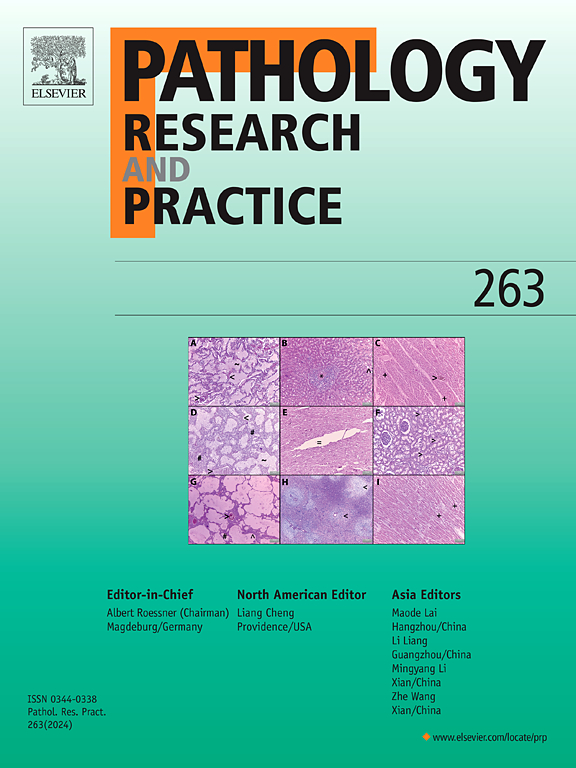Toll-like receptors in kidney ischemia-reperfusion injury: Modulating macrophage responses for therapeutic insights
IF 2.9
4区 医学
Q2 PATHOLOGY
引用次数: 0
Abstract
Kidney ischemia-reperfusion (I/R) injury is an acute clinical condition associated with inflammation and tissue damage during and after ischemia and reperfusion periods. In I/R injury, macrophages contribute to injury, and a family of proteins called toll-like receptors seem to have an immune modulatory role. When activated, TLRs initiate a series of signaling pathways, including MyD88 and TRIF. These pathways regulate the activation of tissue macrophages into either ‘classically activated’ M1 or ‘alternatively activated’ M2 phenotypes. Indeed, the relative abundance of these macrophage phenotypes defines the tissue injury level, which consequently requires reparative processes. The initial effector pro-inflammatory M1 macrophages aggravate tissue injury. Conversely, tissue reparative and anti-inflammatory M2 macrophages promote tissue repair and resolution—increased TLR signalling results in increased inflammation, prolonged healing and even renal failure. New evidence indicates that the change of macrophage responses through pharmacological targeting of the TLR pathways that regulate inflammation and tissue repair may have therapeutic implications. Some experimental treatment methods, in which early phases have been elaborated through experimental animal models, are TLR antagonists, small molecule inhibitors and nanotechnology-based delivery systems for Antisense oligonucleotide. Nevertheless, because the pathways regulated by TLRs and the subsets of macrophages are so countless and entangled, more extensive study is needed to provide more targeted actions. These findings shed light on the role and regulation of TLRs in macrophages during kidney I/R injury and investigate potential treatments with the potential to enhance care in this highly damaging condition.
肾缺血再灌注损伤中的toll样受体:调节巨噬细胞反应的治疗见解
肾缺血再灌注(I/R)损伤是一种在缺血再灌注期间和之后与炎症和组织损伤相关的急性临床状况。在I/R损伤中,巨噬细胞有助于损伤,一种称为toll样受体的蛋白质家族似乎具有免疫调节作用。当被激活时,tlr启动一系列信号通路,包括MyD88和TRIF。这些途径调节组织巨噬细胞的激活,使其变成“经典活化”的M1型或“选择性活化”的M2型。事实上,这些巨噬细胞表型的相对丰度决定了组织损伤水平,因此需要修复过程。初始效应的促炎M1巨噬细胞加重组织损伤。相反,组织修复和抗炎M2巨噬细胞促进组织修复,TLR信号的分辨率升高导致炎症增加,愈合时间延长,甚至肾功能衰竭。新的证据表明,通过药物靶向调节炎症和组织修复的TLR通路来改变巨噬细胞反应可能具有治疗意义。一些实验治疗方法是TLR拮抗剂、小分子抑制剂和基于纳米技术的反义寡核苷酸递送系统,其中早期阶段已经通过实验动物模型进行了阐述。然而,由于tlr和巨噬细胞亚群调节的途径是如此之多和纠缠,需要更广泛的研究来提供更有针对性的作用。这些发现揭示了肾I/R损伤期间巨噬细胞中TLRs的作用和调节,并探讨了潜在的治疗方法,有可能加强对这种高度损伤性疾病的护理。
本文章由计算机程序翻译,如有差异,请以英文原文为准。
求助全文
约1分钟内获得全文
求助全文
来源期刊
CiteScore
5.00
自引率
3.60%
发文量
405
审稿时长
24 days
期刊介绍:
Pathology, Research and Practice provides accessible coverage of the most recent developments across the entire field of pathology: Reviews focus on recent progress in pathology, while Comments look at interesting current problems and at hypotheses for future developments in pathology. Original Papers present novel findings on all aspects of general, anatomic and molecular pathology. Rapid Communications inform readers on preliminary findings that may be relevant for further studies and need to be communicated quickly. Teaching Cases look at new aspects or special diagnostic problems of diseases and at case reports relevant for the pathologist''s practice.

 求助内容:
求助内容: 应助结果提醒方式:
应助结果提醒方式:


